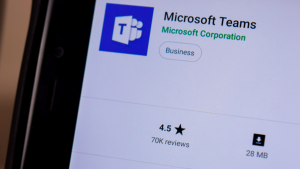- Adam Mansfield
- Reading Time: 3 minutes

Embracing Linux
In a recent Microsoft blog aimed at the open source community at work, the company announced that Teams is now available for Linux users in public preview. This is a smart move by Microsoft and one that was bound to happen as it continues to focus on getting more use of their collaboration app, Teams, and cloud productivity offerings, like Office 365. I expect to look back on this as the first of many Microsoft announcements to come as the company makes more cloud offerings available on Linux, with the end goal of making the Microsoft 365 all-in cloud subscription bundle (which includes Office 365, Windows 10, and Enterprise Mobility + Security (EMS)) available for Linux users.
It makes sense that they are starting with Teams as Microsoft knows it is one of the best gateways to Office 365 adoption which includes Teams and eventually, Microsoft 365 adoption. If Microsoft can get Teams usage in the open source community, it will make Office 365 and Microsoft 365 usage that much easier to win.
Making Teams available for Linux helps remove friction, a very real obstacle that has been preventing use by this community given the fact that there are many devices that have Linux as the platform (not Windows) and Linux is being used in many enterprises and educational institutions.
Why Extend Teams Access to Linux Users to Accelerate Use?
Beyond the fact that use typically leads to more dollars, Microsoft has been aggressively and publicly challenged by competitor Slack on whether their usage numbers are legitimate. Slack happens to already be available on Linux and has been making the point that though they may have less daily active users, what matters more is that Slack users are more engaged with its platform. There has also been a lot of discussion around whether Microsoft enterprise customer users are being counted as users of Teams just because they subscribe to Office 365, which includes Teams.
Microsoft also knows that the collaboration market is a competitive one. Beyond Slack, you have Google pushing Hangouts and even Facebook out there looking to grab enterprise market share with their Workplace by Facebook collaboration offering. Microsoft knows that getting actual use from as broad an audience as possible is one of the best ways to win a competitive battle like this.
Continuing to focus their efforts, time, and vast amounts of dollars on getting more Teams users to accelerate overall usage at Microsoft’s current customers, they will also aim to keep competitors like Google, Slack, and Facebook out of Microsoft’s current base. They are concentrating on those that are already using Teams and those that have access to it through their Office 365 subscription (or will, now that it is available on Linux).
Microsoft 365 and Teams for Consumers
In order to help accelerate enterprise use, Microsoft also recently announced that it will be launching a new consumer version of Microsoft’s enterprise cloud bundle subscription offering, Microsoft 365. “Microsoft 365 Life” (or M365 Life) is expected to be rolled out to the consumer market in the spring of 2020.
M365 Life is expected to include a consumer version of Microsoft Teams as well. The expected “Teams for Life” is something Microsoft has been working on and it will include collaboration-related features and capabilities like document sharing, the ability to send locations, and share family calendars.
Just as Microsoft is looking to the open source community to drive more usage through making Microsoft Teams and eventually making Microsoft 365 available on Linux, it is looking to the consumer market to do the same.
Consumers make up the workforce that enterprises employ. If Microsoft can get more consumer use, they are hoping that these individuals will be familiar with its product offerings and thus will be more productive using the Microsoft cloud solution on day one of employment. The thinking would be that enterprises will be more likely to lean towards Microsoft’s offering, or stick with it if already adopted, instead of moving away towards Google’s G Suite and Hangouts competing offerings. This is especially the case when Microsoft 365 F1 or even Office 365 F1 is under consideration given these offerings are geared towards enterprise’s firstline workers (e.g., employees on the retail shop floor).
The Bottom Line
Microsoft is going to do everything it can to accelerate usage because it knows that it is the way to drive revenue and keep competitors out. Enterprise customers need to understand that how they prepare for Microsoft’s aggressive and widespread approach is going to have a significant impact on the enterprise’s ability to maintain control of the relationship they have, today and in the future. If the proper plan is not in place and if the resulting pricing and contractual structure is not what it should be, it will not only be problematic in the short-term but it could be devastating longer-term as the inevitable fly-wheel effect tied to the usage of these cloud products kicks into overdrive.
Related Blogs
SaaS Price Increases: What If Vendors Only Charged More When You Got More?
Microsoft Ends EA Volume Discounts: What It Means and How to Respond
Strategic Microsoft Renewal Scenarios: How to Prepare and Stay in Control
About the Author
